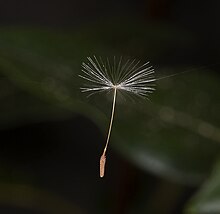
A dispersal vector is an agent of biological dispersal that moves a dispersal unit, or organism, away from its birth population to another location or population in which the individual will reproduce.[1][2] These dispersal units can range from pollen to seeds to fungi to entire organisms.
There are two types of dispersal vector, those that are active and those that are passive. Active dispersal involves pollen, seeds and fungal spores that are capable of movement under their own energy. Passive dispersal involves those that rely on the kinetic energy of the environment to move. In plants, some dispersal units have tissue that assists with dispersal and are called diaspores. Some types of dispersal are self-driven (autochory), such as using gravity (barochory), and does not rely on external agents. Other types of dispersal are due to external agents, which can be other organisms, such as animals (zoochory), or non-living vectors, such as the wind (anemochory) or water (hydrochory).[2]
In many cases, a dispersal unit will be dispersed by more than one vector before reaching its final destination. It is often a combination of two or more modes of dispersal that act together to maximize dispersal distance, such as wind blowing a seed into a nearby river, that will carry it farther down stream.[3]
- ^ Croteau, Emily K (2010). "Causes and Consequences of Dispersal in Plants and Animals". Nature.
- ^ a b Frank M. Schurr; Orr Spiegel; Ofer Steinitz; Ana Trakhtenbrot; Asaf Tsoar; Ran Nathan (2009). "Long-Distance Seed Dispersal". In Lars Østergaard (ed.). Fruit development and seed dispersal. Volume 38 of Annual Plant Reviews. John Wiley and Sons. pp. 204–237. doi:10.1002/9781444314557.ch6. ISBN 978-1-4051-8946-0.
- ^ Merritt, David M.; Wohl, Ellen E. (August 2002). "Processes Governing Hydrochory Along Rivers: Hydraulics, Hydrology, and Dispersal Phenology". Ecological Applications. 12 (4): 1071–1087. doi:10.1890/1051-0761(2002)012[1071:pgharh]2.0.co;2. ISSN 1051-0761.
